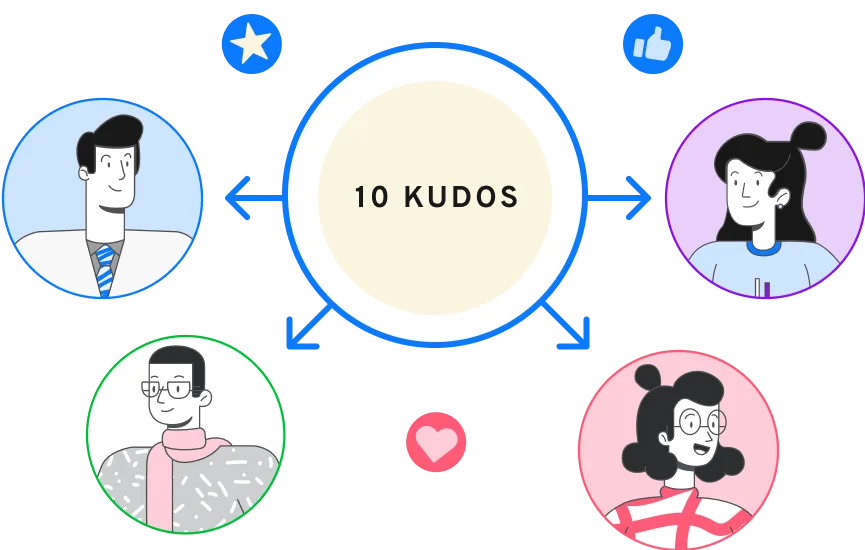Negativity in the workplace is more than just a passing mood. When left unchecked, it can quietly spread throughout a team or even an entire company, undermining morale, lowering productivity, and chipping away at your organization’s culture. Whether you’re an HR leader, team manager, or business owner, knowing how to deal with negative employees is an essential skill for building a resilient, motivated workforce.
Employees want to feel valued and included. The way leaders handle negativity—proactively and empathetically—can be the difference between a thriving culture and a disengaged team. In this guide, we’ll explore actionable ways and ideas to address negativity, focusing on strategies that not only resolve issues but also drive lasting engagement and positivity.

How SwagMagic can help your brand?
- Bulk Buy & Save on your gifts!
- Curate Customized Swag Boxes!
- Launch Your Store for your employees!
- Secure Swag Storage with us!
Table of contents
- Understanding Negative Employees
- The Cost of Unaddressed Negativity
- 7 Effective Ways to Deal with Negative Employees
- 1. Open Communication with Appreciation & Constructive Feedback
- 2. Set Clear Expectations and Accountability
- 3. Foster a Positive Work Environment
- 4. Provide Opportunities for Growth and Support
- 5. Use SwagMagic for Employee Engagement & Positive Reinforcement
- 6. Address Root Causes and Offer Help
- 7. Know When to Escalate or Transition
- Swagmagic: Your Solution Provider for Building a Positive Workplace
Understanding Negative Employees
Before jumping to solutions, it’s important to understand why some employees display persistent negativity. Not all negative behavior stems from the same root, and identifying the cause is the first step toward meaningful resolution.
Common Causes of Negativity
- Personal Issues: Stress outside work, health problems, or family concerns can spill over into workplace behavior.
- Workplace Stress: Overwork, unclear job expectations, and lack of resources are frequent triggers.
- Poor Leadership: Lack of direction, inconsistent feedback, or favoritism from managers can breed resentment.
- Team Dynamics: Unhealthy competition, bullying, or a toxic work environment may turn even enthusiastic employees negative.
Signs and Behaviors
Look for these indicators:
- Frequent complaining or cynicism
- Resistance to change or new initiatives
- Poor teamwork and low engagement
- Spreading gossip or undermining others
- Decline in performance or attendance
Early identification of these patterns allows leaders to address negativity before it escalates.
Curate the perfect box of handpicked gift they’ll love and send joy their way

The Cost of Unaddressed Negativity
Unchecked negativity isn’t just an HR headache—it’s a real business risk.
- Effects on Morale and Productivity
A single negative employee can disrupt team harmony and lower morale. Over time, this erodes collaboration and creative thinking, leading to lost productivity.
- Impact on Company Culture and Brand
When negativity spreads, it shapes the company culture and may even damage the employer brand. Top performers are more likely to leave, and recruiting new talent becomes harder.
- Increased Turnover
Studies show that toxic behaviors are contagious. One negative employee can drive away multiple valuable team members, resulting in higher turnover and increased hiring costs.

7 Effective Ways to Deal with Negative Employees
Successfully addressing negativity involves a blend of empathy, structure, and proactive engagement. Here are seven proven ways to turn negative attitudes into positive action:
1. Open Communication with Appreciation & Constructive Feedback
- Schedule a Private Meeting: Don’t address negativity in a group or during high-pressure moments. Instead, arrange a confidential meeting where the employee feels safe and respected. Start with an open-ended question like, “How have you been feeling about your work lately?”
- Prepare with Specific Examples: Before the meeting, gather concrete examples of the negative behaviors you’ve observed (e.g., repeated cynicism in meetings, reluctance to participate in team projects). Avoid vague feedback—specificity removes ambiguity and defensiveness.
- Practice Active Listening: Allow the employee to express their perspective fully. Maintain eye contact, nod, and occasionally paraphrase what they say to show understanding. Use prompts like, “Can you tell me more about that?” or “How did that make you feel?”
- Share Your Observations Calmly: Use “I” statements to describe the impact of their behavior (“I’ve noticed that team morale drops when complaints are voiced in meetings. I’m concerned about how this affects everyone.”).
- Collaborate on Solutions: Invite the employee to co-create a plan for improvement. For example, ask, “What support do you need to feel more positive?” or “What changes would help you contribute more constructively?”
- Document the Discussion: After the conversation, send a follow-up email summarizing key points, agreed actions, and next steps. This keeps everyone accountable and clarifies expectations.
Why This Works
- Builds Trust and Respect: Addressing negativity privately shows respect for the employee and demonstrates that you’re committed to their growth, not just “calling them out.”
- Clarifies Misunderstandings: Sometimes, employees aren’t even aware of the impact of their attitude. Honest feedback helps them see the bigger picture.
- Encourages Engagement: Employees who feel listened to are more likely to engage with improvement plans and feel a renewed sense of purpose.
- Lays the Foundation for Change: Open communication is the first step toward transforming negative attitudes and repairing damaged relationships.

2. Set Clear Expectations and Accountability
- Define Job Roles in Writing: Create or update written job descriptions outlining duties, performance standards, and behavioral expectations. Share these with your team and review them regularly.
- Establish Measurable Goals: Use the SMART goal framework (Specific, Measurable, Achievable, Relevant, Time-bound) during quarterly or monthly check-ins. For example: “Respond to internal emails within 24 hours,” or “Participate actively in two team meetings per week.”
- Reinforce Company Values: Integrate your company’s core values (like respect, collaboration, or customer focus) into everyday conversations and performance reviews. Display them visually in the office or share them digitally.
- Track Progress: Use performance management tools or regular one-on-ones to review goal achievement. Provide feedback in real time rather than waiting for annual reviews.
- Implement a Feedback Loop: Encourage employees to ask questions or request clarification at any time. Make feedback a two-way street, welcoming suggestions for improvement.
Why This Works
- Reduces Ambiguity: When employees know exactly what’s expected of them, there’s less room for misinterpretation or resentment.
- Promotes Fairness: Transparent standards ensure everyone is measured equally, reducing feelings of favoritism or unfairness.
- Motivates Positive Change: Employees who see progress toward clear goals feel a greater sense of accomplishment and are more likely to stay motivated.
- Enables Early Intervention: Regular tracking makes it easier to spot negative trends early and intervene before they become serious issues.
3. Foster a Positive Work Environment
- Organize Team-Building Activities: Plan monthly team lunches, volunteer days, or online games for remote teams to help employees connect in a low-pressure environment.
- Celebrate Small Wins: Use team meetings or group chats to highlight individual contributions (“Thanks to Sarah for handling the client call so smoothly yesterday!”). SwagMagic can automate or supplement these celebrations with branded swag.
- Create Peer Recognition Programs: Encourage employees to nominate colleagues for “Employee of the Month” or similar awards, fostering a culture of mutual respect.
- Ensure Inclusivity: Make sure all voices are heard by rotating meeting leaders, seeking input from quieter team members, and honoring diverse holidays or events.
- Maintain a Welcoming Space: For in-office teams, invest in comfortable common areas, plants, and natural light. For remote teams, encourage “virtual coffee breaks” or informal check-ins.
Why This Works
- Increases Belonging: When employees feel like part of a community, negativity is less likely to take hold. A supportive team environment builds trust and morale.
- Encourages Positive Behavior: Peer recognition and shared celebrations reinforce desired behaviors and shift focus from individual complaints to team achievements.
- Reduces Stress: Social support and a sense of inclusion act as natural buffers against stress and burnout, which are common triggers for negativity.
- Builds Resilience: Teams with strong bonds bounce back faster from challenges, making it easier to weather tough times without descending into negativity.
4. Provide Opportunities for Growth and Support
- Offer Skills Training: Identify areas where the employee might want to grow (public speaking, project management, technical skills) and provide workshops, courses, or certifications.
- Create Mentorship Programs: Pair negative employees with positive, high-performing mentors for regular check-ins and advice. This also builds a sense of partnership.
- Encourage Lateral Moves: If the employee seems disengaged, offer the chance to switch roles or projects that better match their interests and strengths.
- Set Up Regular Development Check-Ins: Use monthly one-on-ones to discuss career ambitions, growth opportunities, and personal goals. Help employees map out a realistic path forward.
- Offer Wellness Resources: Provide access to mental health resources, stress-management seminars, or flexible scheduling for work-life balance.
Why This Works
- Combats Boredom and Burnout: Lack of challenge or career stagnation often leads to negative attitudes. New opportunities reignite enthusiasm and commitment.
- Demonstrates Investment: When employees see that leadership is invested in their future, they feel valued and are more likely to reciprocate with positive engagement.
- Helps Discover Hidden Talents: Employees who shift to new roles or develop new skills often uncover strengths that benefit the whole team.
- Reduces Turnover: Growth and support programs make it less likely that negative employees will “check out” or look for opportunities elsewhere.
5. Use SwagMagic for Employee Engagement & Positive Reinforcement
- Set Up a SwagMagic Campaign: Launch an employee recognition campaign using SwagMagic’s dashboard. Decide on occasions (monthly achievements, project completions, birthdays, etc.) and types of rewards.
- Assign Swag Points for Positive Behaviors: Award points for contributions like going above and beyond, helping colleagues, or showing improvement after feedback. Employees redeem points for swag of their choice—apparel, tech, drinkware, or wellness items.
- Automate Peer-to-Peer Recognition: Enable integrations with Slack, Teams, or your HRIS so employees can nominate each other for instant recognition and points, which builds a culture of appreciation.
- Personalize Rewards: Use SwagMagic to create custom swag kits—include the company logo, a handwritten card, or branded packaging. For remote teams, send swag directly to employees’ homes, no matter where they are.
- Track Engagement: Use SwagMagic’s analytics to see which recognition programs are most popular and which items employees choose, allowing you to refine future campaigns.

Why This Works
- Boosts Morale Instantly: Personalized rewards make employees feel seen and valued right away. Tangible recognition (not just verbal praise) has a lasting positive impact.
- Encourages Positive Change: Employees are more motivated to adopt positive behaviors when they know they’ll be rewarded in a meaningful way.
- Builds a Culture of Appreciation: Peer-to-peer gifting reinforces a supportive team environment, reducing the isolation and resentment that breed negativity.
- Scalable and Inclusive: SwagMagic’s global fulfillment ensures every team member—on-site, remote, or international—feels included in the recognition, no matter their location.
- Saves Time for Leaders: Automated recognition campaigns mean leaders can consistently celebrate wins and positive changes without the administrative hassle.
6. Address Root Causes and Offer Help
- Observe and Identify Patterns: Keep an open mind and look for recurring triggers (tight deadlines, specific projects, interpersonal conflicts). Use surveys, one-on-ones, or anonymous feedback to dig deeper.
- Refer to Employee Assistance Programs (EAPs): Proactively share information about counseling, mental health support, or financial guidance available through your EAP.
- Promote Wellness Initiatives: Organize wellness days, mindfulness workshops, or offer flexible work hours so employees can recharge.
- Encourage Transparency: Remind employees it’s okay to ask for help and that everyone faces challenges from time to time. Model this openness yourself as a leader.
- Adjust Workload or Environment: If an employee is overwhelmed, redistribute tasks or allow temporary remote work to alleviate stressors.
Why This Works
- Shows Empathy: Addressing root causes demonstrates that you care about employees as people, not just as workers. This fosters loyalty and trust.
- Solves Problems, Not Symptoms: Targeting the underlying issue leads to sustainable change, rather than temporary fixes.
- Reduces Recurrence: Employees who receive help are less likely to fall back into negative patterns.
- Improves Overall Well-Being: Support programs and wellness initiatives help everyone, not just negative employees, making the workplace healthier and more resilient.
7. Know When to Escalate or Transition
- Document All Steps: Keep detailed records of feedback conversations, improvement plans, and actions taken. This protects both the employee and the company.
- Follow Progressive Discipline: Start with verbal warnings, followed by written warnings, and then formal performance improvement plans if needed. Explain consequences clearly at each stage.
- Involve HR Early: Bring HR into ongoing issues for mediation, advice, and support. Their presence helps ensure fairness and compliance with company policy.
- Consider a Role Change: If negativity seems role-specific, discuss the possibility of transferring the employee to another department or position that better suits their skills and temperament.
- Plan for Separation as a Last Resort: If all efforts fail, prepare for a respectful and legal transition out of the company. Focus on protecting your culture and supporting the rest of the team.
Why This Works
- Protects Team Morale: Escalation shows your commitment to maintaining a positive, productive environment for everyone—not just the individual in question.
- Ensures Fairness and Transparency: Following documented processes keeps everyone on the same page and reduces potential legal risks.
- Provides Multiple Chances for Improvement: Employees receive clear opportunities to turn things around before facing serious consequences.
- Sustains Company Culture: Sometimes, letting go of persistently negative employees is necessary to preserve a healthy workplace for everyone else.

Swagmagic: Your Solution Provider for Building a Positive Workplace
Dealing with negativity is never easy, but you don’t have to do it alone. SwagMagic is designed to empower leaders, HR teams, and organizations to drive engagement, build positive cultures, and recognize employees in ways that matter.
Key SwagMagic Solutions for Addressing Negativity:
- Custom Swag Kits for onboarding, appreciation, and milestone recognition
- Points-based Rewards System allowing for employee choice and instant recognition
- Global Fulfillment for remote and hybrid teams, making everyone feel included
- Peer-to-Peer Gifting to reinforce positive behaviors and teamwork
- Seamless Integrations with HRIS, Slack, and other platforms for easy, automated recognition
- No Minimum Swag Orders so you can send meaningful rewards even for small teams or one-on-one gestures

SwagMagic takes care of logistics, customization, and global delivery, so you can focus on building a happier, more engaged workforce. If you’re looking to proactively boost morale and transform negativity into positivity, SwagMagic is the all-in-one solution you need.
Talk to SwagMagic experts to learn how your company can start driving positive change today!
Employees may become negative due to personal stress, unclear job expectations, lack of recognition, poor leadership, or toxic team dynamics. Identifying the root cause is the first step in turning things around.
Recognition—especially when it’s personal and meaningful—makes employees feel valued and appreciated. SwagMagic lets you easily reward positive change, celebrate milestones, and boost morale, helping to replace negativity with enthusiasm.
SwagMagic handles global fulfillment and makes it simple to deliver swag to employees anywhere in the world, supporting inclusion and engagement for all team structures.
Absolutely! SwagMagic offers a wide range of customizable items—from apparel and tech gadgets to wellness kits—so employees can choose rewards that resonate with them.
References:
- Robbins, S. P. (2009). Organizational behavior. Pearson Prentice Hall.
- Amabile, T. M., & Kramer, S. J. (2011). The progress principle: Using small wins to ignite joy, engagement, and creativity at work. Harvard Business Press.
- Herzberg, F. (2003). One more time: How do you motivate employees? Harvard business review, 81(1), 87-96.
- Collins, B. J., Burrus, C. J., & Meyer, R. D. (2014). Gender differences in the impact of leadership styles on subordinate embeddedness and job satisfaction. The Leadership Quarterly, 25(4), 660-671.

Leave a Comment